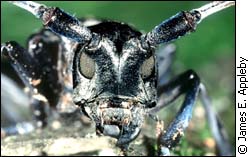| Tracking
a tiny
but deadly menace
By David Baeta
OTTAWA —
A ruthless killer is lurking
in Canada's forests, but, unlike most criminals, this
one's hard to trace and contain — that's because
it's about one inch long.
Despite the beetle's size, scientists
at the Great Lakes Forestry Centre, have devised a way
to easily identify and track down the little perpetrator
— known as the Asian Longhorn beetle.
Dr. Arthur Retnakaran says the beetle’s
DNA is what tells it apart from other beetles. Since
DNA extraction is commonly used in crime scene investigations
involving humans, Retnakaran is applying the same concept
to the world of insects.
 |
| Trunks
and branches of healthy trees are first to feel
the wrath of this beetle as it tunnels through the
bark, nestles in the hardwood, and eventually kill
its host. |
"They [CFS] wanted us to design a
DNA system to detect the beetle, much like the ones
used in forensics," Retnakaran says.
Thanks to his molecular markers, the beetle
can unambiguously be identified — which can simultaneously
save millions of Canadian trees.
Currently, trees anywhere near other infested
trees are simply cut, chipped, and burned.
Forestry workers take no chances with the beetle.
It must be tracked down quickly because it spreads quickly
and, most importantly, it tunnels through the bark and
trunk of trees, which is deadly.
The markers will enable field workers establish if the
beetle has made it’s mark in an area.
»
Full Story
|